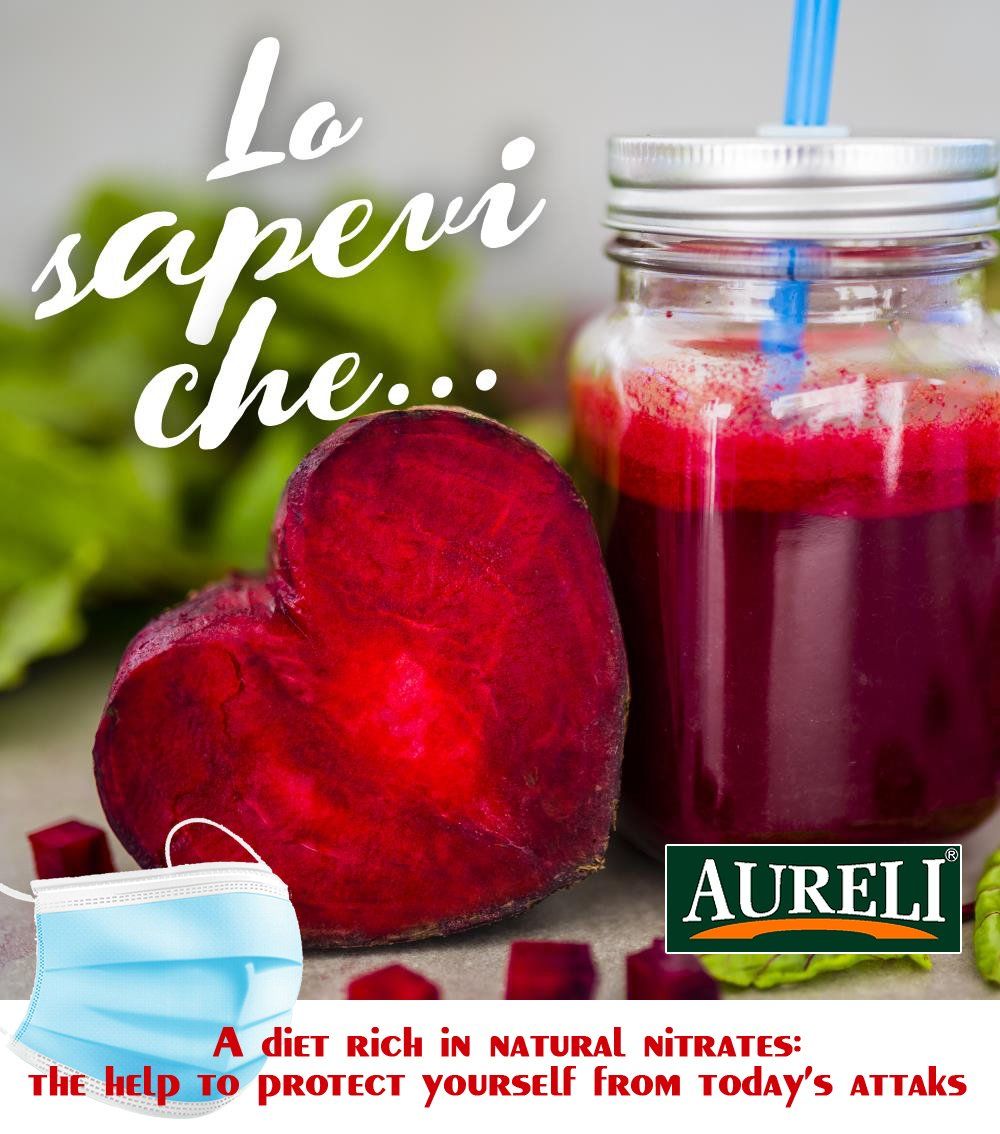Research and Development
19 October 2020
Nitrates in Red Beetroot: why, how much and how to take them to obtain a healthy benefit.
The discovery that the nitrate contained in a vegetable food (inorganic) has important effects on the vascular system is quite recent. It comes from the knowledge of a process of formation of nitric oxide, the active molecule into blood vessels, through a nitrate-nitrite-nitric oxide cycle (NO), which begins in the mouth, due to bacterium actions, and continues into the stomach and blood (into microvessels) in relation to the amount of blood oxygen [1]. Until a decade ago, in the West, the health effects of vegetable nitrates were not known; National and International Institutions in charge of food safety and consumer health were more focused on evaluating the risks of taking nitrates and nitrites as food additives, especially for preserved meats.
WHY:
In recent years, it has been demonstrated that vegetable dietary rich in nitrate has numerous healthy benefits on the vascular system, such as the reduction of blood pressure, the inhibition of plate aggregation, the prevention or improvement of endothelial function, improvement of physical performance in healthy individuals and those patients who suffers from peripheral arterial disease [2, 3]. In the last few months, a diet rich in vegetables with a high content of nitrates has been suggested to be effective in dealing with the vascular consequences of SARS COV2 (COVID 19) infection [4].
The advantage of taking nitrates through the vegetable diet compared to the assumption of nitrates in tablets (drugs) is simple. In the vegetables there are both antioxidant molecules (water-soluble and fat-soluble) and fibers, they prevent the transformation of nitrates into nitrosamines (harmful molecules) and facilitate the maintenance of normal bacterial flora, intestinal function and immune defenses [5].
In 2008, the expert group of the European Food Safety Authority (EFSA) on Contaminants in the Food Chain (CONTAM) evaluated vegetables nitrates’ risks and benefits for consumers and concluded that the healthy benefits go beyond the potential risks resulting from exposure to nitrates through vegetables. Furthermore, the CONTAM group concluded that nitrate levels in leaf vegetables are not a concrete risk for children [6].
HOW MUCH:
In 2002, the Joint FAO-WHO Committee on Food Additives (JECFA), and then EFSA in 2010, set the Acceptable Daily Intake (ADI) at 3.7 mg / kg body weight per day [5], equal to a total amount in millimoles from 3 to 5.4 for a body weight that goes from 50 up to 90 kg.
This amount can be greatly increased up to 20 mmol for an 80 kg man if his diet includes vegetables with a high content of Nitrates, such as the Dietary Approaches to Stop Hypertension (DASH) [7]. It is interesting to note that this intake is approximately 5 times higher than the World Health Organization's acceptable daily intake.
Beetroot (Beta vulgaris rubra) together with rocket, lettuce, radicchio and spinach, is the group of vegetables with a higher nitrate content (greater than 1000 mg per kg on average). Since each of these vegetables has different composition in micronutrients and fibers, their dietary intake will lead to diversified health benefits.
HOW:
In recent years, the international scientific literature has focused a lot on red beetroot as a food rich in nitrates, recommended for sportsmen and for people that suffers from hypertension, metabolic syndrome, viral infections that can hurt microvessels (such as COVID 19). Particularly, clinical studies were mostly conducted on subjects who used to drink either daily or sporadically the beet juice in acute form from 70 up to 500 mL [8].
Why vegetable juice and not the whole beet? The methodical intake of this food in the form of a juice, which has been produced with professional processes, is prescribed as follows:
1) The beetroot should be cooked to be easy to digest. However, the cooking process can vary the availability of both nitrates and antioxidant molecules.
2) In order to have a healthy benefit from this vegetable, the amount of nitrates and antioxidants must be well-known. The quantity varies according to the variety of the seed, the type of the soil, the climatic conditions, the specific agronomic techniques, and, above all, the sharpening of the transformation processes from raw material to finished product (juice). All the previous mentioned features, associated with the constant control of the qualitative and quantitative components, ensures the maintenance of healthy properties.
1) Lundberg JO, Weitzberg E, Gladwin MT. The nitrate-nitrite-nitric oxide pathway in physiology and therapeutics. Nat Rev Drug Discov. 2008; 7: 156-67. doi: 10.1038/nrd2466.
2) Lidder S, Webb AJ. Vascular effects of dietary nitrate (as found in green leafy vegetables and beetroot) via the nitrate-nitrite-nitric oxide pathway. Br J Clin Pharmacol. 2013;75 :677-96. doi: 10.1111/j.1365-2125.2012.04420.x.
3) Mirmiran P, Houshialsadat Z, Gaeini Z, Bahadoran Z, Azizi F. Functional properties of beetroot (Beta vulgaris) in management of cardio-metabolic diseases. Nutr Metab (Lond). 2020 Jan 7;17:3. doi: 10.1186/s12986-019-0421-0.
4) Ozdemira B., Yazicib A - “Could the decrease in the endothelial nitric oxide (NO) production and NO bioavailability be the crucial cause of COVID-19 related deaths? - Medical Hypotheses 2020; 144: 109970
5) Zamani H, de Joode MEJR, Hossein IJ, Henckens NFT, Guggeis MA, Berends JE, de Kok TMCM, van Breda SGJ. The benefits and risks of beetroot juice consumption: a systematic review. Crit Rev Food Sci Nutr. 2020, 15: 1-17. doi: 10.1080/10408398.2020.1746629.
6) LA VALUTAZIONE DEL RISCHIO SPIEGATA DALL‘EFSA. NITRITI E NITRATI AGGIUNTI AGLI ALIMENTI. EFSA 2018. Pdf
7) Susanna C. Larsson, Alice Wallin, and Alicja Wolk. Stroke. Dietary Approaches to Stop Hypertension (DASH) Diet and Incidence of Stroke. Stroke: 2016; 47: 986–990
8) Clements WT, Lee SR, Bloomer RJ. Nitrate ingestion: a review of the health and physical performance effects. Nutrients. 2014;6: 5224-64. doi: 10.3390/nu6115224.





